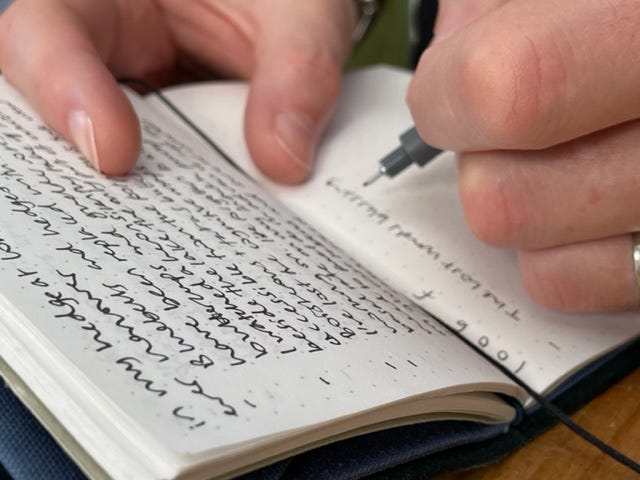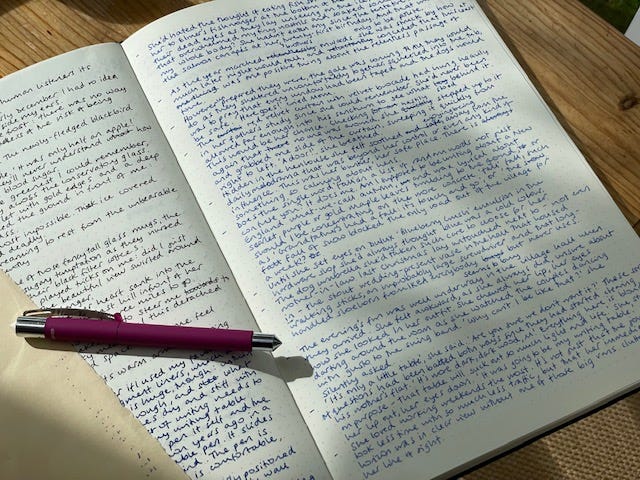Dear Reader,
Where would a writer be without her pen and paper?
The tools for writing are pretty basic, and they’re very personal to the writer. How we feel about the physical act of writing is what leads us to our most comfy tools – if we’re not comfortable with how we write, we’re not going to write.
Writers have got to write, right?
Notebooks are my thing. Hands up stationery geeks: yes ma’am, that’s me. I have three – although if I had to relinquish my two most recent acquisitions, bought specifically for my daily writing, I think I’d still cope with just my A5 bullet journal. All of my notebooks have dot-grid pages, because I like the guidelines of a grid and the ability to use the pages in either portrait or landscape format. A lined notebook of course only works the right way up, and my lines of words would lose all control in a plain one!
I love my tiny go-everywhere passport-sized notebook for the weight and space it saves in my back pocket, despite it being a size which my previous self had condemned as unusable. Yet opened out and turned 90 degrees, the resulting double-page spreads aren’t far off the size of the pages in my bullet journal, which makes this little book perfect for jotting down ideas for my writing when I’m at work or out walking. Its presence in my pocket comforts me with its papery promise that I’m never going to miss the opportunity to record something that I might want to harness in the future.

The notebook I couldn’t do without is my A5 bullet journal. I live my life by this book – it bears the weight of my daily to-do lists, my journalling musings, notes of what happened today, logs of the medication I take, and perhaps a recipe I’ve jotted down that a friend’s been raving about. All sorts of everything. Anything I might need to refer to gets noted in here, to be found in the future thanks to the index. Yes, I index my notes. It’s an invaluable practice. The A5 pages of this book are perfect: big enough to contain what they need to; small enough for the book to be easily portable around the house, or in my bag when I’m out.
I find longform writing needs longer lines than an A5 notebook can offer, which is where my big writing journal comes in. You see, when I try to settle down to write write in an A5 notebook I am frustrated by the limited space on offer, and perhaps unsurprisingly I find myself distracted by my compulsion to write lists instead! My A4+ sized writing journal encourages me with its tall, wide expanse of paper real estate, yet I don’t feel daunted by the amount of space to be filled. It reassures me to see that I have plenty of room for my words to flow, be crossed out or be reordered on the page.
The right pen, too, is important. It’s a very personal thing: of course we all have our favourites. And we have different pens for different purposes. For writing birthday cards, for instance, I always use a black Bic biro – the insides of greetings cards are so variable, ranging from mirror shiny to super absorbent, neither of which will handle a decent pen – and I know that I can always find a Bic biro attached to the clipboard in the kitchen which holds my shopping list.
I love the Staedtler pigment liners I use every day for both my bullet journal and my passport notebook because the ink dries so quickly and is permanent. The latter is particularly important – I wash my hands such a lot (thanks, Covid!), and don’t always seem to dry them properly. Making a note of something with beads of water dripping from my bracelets would smudgily scupper any page written in washable ink!
Ask me how I know this…
The downside of my everyday pens is their limited lifespan, with a pigment liner only lasting a couple of weeks at the coal face of my bullet journalling activities. I was reminded of this hopeless characteristic when I started using them in my new writing journal and found that the tip would soon get eaten up by my word mileage and be anything but smooth.
Now, if I’m writing miles of words a day, smooth is what I’m after. Smooth ink smoothly applied to smooth paper, line after line. So invoking smooth, I reached for my bright pink fountain pen.
Except I didn’t. I couldn’t find it. Eventually – in fact while in search of a very particular hair accessory and identifying in the process yet another domestic decluttering job to put on my list – I found myself digging around in the top drawer of my dressing table. There was my fountain pen. To my delight it even had a spare cartridge in the barrel.
An aside: I have history with fountain pens. In Form A at junior school we’d had to use pencils, and were properly trained to dutifully rub out any mistakes. Later on, our Form B teacher explained to us that now was the time to start making an effort with our handwriting, using a fountain pen and washable blue ink to ‘do your writing justice’. She was soon despairing of our inky books, desks, clothes and fingers.
I’d never yet seen an ink eraser, and once they came onto the scene in the late 1980s any found on school property would immediately be confiscated. We yearned for those innocent days of writing in pencil, and for the security and confidence offered by a rubber.
But this was Form B. ‘Just cross it out!’ we were told. A perfectionist from an early age, I would beg to tear a page out of my book rather than have a mistake on show. ‘You need to show your mistakes, Rebecca. How else will you learn?’
Well, pink pen found, I set about discovering how proper ink from a decent nib would compare with the scratchy tips of my pigment liners. Reader: ink and words both flow from this pen! Turns out that fountain pens don’t need posh handwriting or even decent words in the right order to do themselves justice – they’re just a smooth way of getting the words out of my head and onto paper. With pigment liners now reserved for my smaller notebooks, the words on the pages of my writing journal are a pleasing blue, not black, and because they’re written in a fast flow of wet ink and get-them-down-quick moments of imagination, they’re direct, authentic and honest, not dried out and laboured.

Crossings out, omission marks, blots and scribbles all flow out of my pen along with the words. They’re the evidence of the immediacy of my craft. Compared to what I’ve been used to, though, the ink is slow to dry, and I’ve found blotting paper to be my life raft. I mentioned to Dad that I needed a sheet, just one, and he came up with the goods: a tatty, dog-eared piece the colour of milky tea, already branded with his own writing leftovers. It’s perfect! I don’t mind that it’s a little too wide and sticks out of the side of my writing journal, because again, I love its authenticity. I use it all the time, and like my other tools it makes my writing adventure real.
This stationery geek – no, I’m going to call myself a writer – cherishes her three notebooks and the pink fountain pen that had been missing in action. As writers we would be nothing without the simple tools to put our words onto paper.
Thank you for reading! Keep well.
Love,
Rebecca
If you enjoyed this post, please let me know by clicking the heart. Thank you!
Thank you for reading! If you enjoy ‘Dear Reader, I’m lost’, please share and subscribe for free.
Interested to know more about my notebooks and pens?
Bullet journal: A5 dot grid 1917 Leuchtturm original bullet journal edition.
For more information about bullet journalling from the system’s inventor, Ryder Carroll, check out www.bulletjournal.com.Pocket notebook: Passport-sized notebook in blue leather by Traveler’s Company with a dot-grid insert.
Writing journal: Leuchtturm Master Classic (A4+).
Pens: Staedtler 0.3 pigment liners and a Stabilo beYou fountain pen.
What tools can’t you do without? Let me know below what you use in your own writing practice!





Hi Mary, thanks for your comment! 3,000 books is a LOT - and gosh, I can quite understand that you missed them when you were parted for a time. Having been an avid reader for decades I had a long spell - only identifiable with hindsight - in which I found I'd let screen time take over too much of my existence as a reader. I only really noticed once life had begun to feel different, and I realised, like an idiot, that I was just being spoon-fed high-energy 'content' rather than self-accessing words to fuel and colour my own imagination.
Embarrassed to admit this!
Hi, Rebecca, Get this: I own about 3,000 books--and had to live without them for almost two years when I moved to California and then had to find a way to house them. So, almost all were in book boxes in a long hallway. I actually experienced what I can only term "homesickness" because I missed my books. xo Mary P.S. great post here.